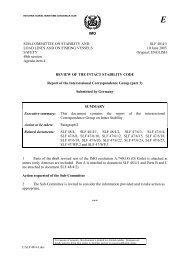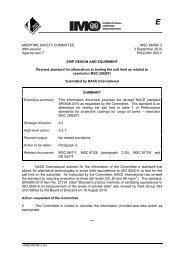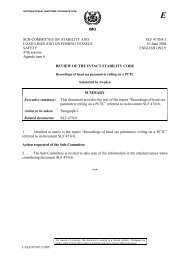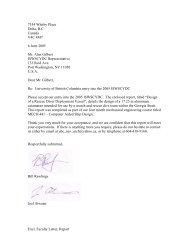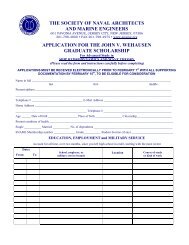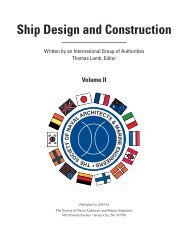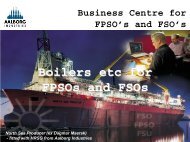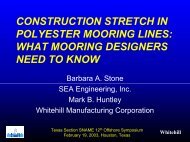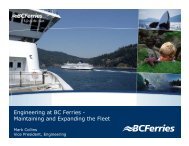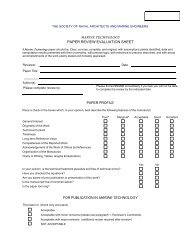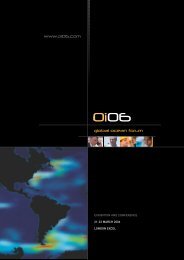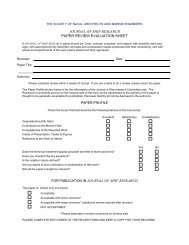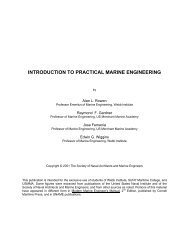IMO SUB-COMMITTEE ON STABILITY AND LOAD ... - SNAME.org
IMO SUB-COMMITTEE ON STABILITY AND LOAD ... - SNAME.org
IMO SUB-COMMITTEE ON STABILITY AND LOAD ... - SNAME.org
You also want an ePaper? Increase the reach of your titles
YUMPU automatically turns print PDFs into web optimized ePapers that Google loves.
INTERNATI<strong>ON</strong>AL MARITIME ORGANIZATI<strong>ON</strong><br />
E<br />
<strong>IMO</strong><br />
<strong>SUB</strong>-<strong>COMMITTEE</strong> <strong>ON</strong> <strong>STABILITY</strong> <strong>AND</strong><br />
<strong>LOAD</strong> LINES <strong>AND</strong> <strong>ON</strong> FISHING VESSELS<br />
SAFETY<br />
49th session<br />
Agenda item 4<br />
SLF 49/WP.1/Add.1<br />
27 July 2006<br />
Original: ENGLISH<br />
PASSENGER SHIP SAFETY<br />
Report of the working group<br />
GENERAL<br />
1 The Working Group on Subdivision and Damage Stability (SDS) met on 26 and<br />
27 July 2006 under the chairmanship of Dr. M. Huss (Sweden) to consider matters related to<br />
passenger ship safety. The outcome of the group’s deliberations on matters related to the<br />
development of explanatory notes for the harmonized SOLAS chapter II-1, the harmonization of<br />
damage stability provisions in other <strong>IMO</strong> instruments, the revision of resolution A.266(VIII) and<br />
the revision of MSC/Circ.650 are set out in document SLF 49/WP.1.<br />
2 The list of representatives and non-governmental <strong>org</strong>anizations that attended the working<br />
group is set out in paragraph 2 of document SLF 49/WP.1.<br />
TERMS OF REFERENCE<br />
3 The working group was instructed, taking into account the comments and decisions made<br />
in plenary, with regard to passenger ship safety, to:<br />
.1 finalize matters related to draft SOLAS regulations II-1/8-1 and II-1/22-1 prepared<br />
by MSC 81 (SLF 49/4/6), taking into account documents SLF 49/4, SLF 49/4/1,<br />
SLF 49/4/3, SLF 49/4/4, SLF 49/4/5 and SLF 49/4/7, and also advise the<br />
Sub-Committee on possible options for the draft amendments to be adopted or<br />
made effective;<br />
.2 consider the relevant provisions of draft regulations II-2/21, 22 and 23 for matters<br />
related to flooding casualties and make recommendations, as deemed appropriate,<br />
taking into account document SLF 49/4/6;<br />
.3 finalize the draft MSC circular on Performance standards for the systems and<br />
services to remain operational for safe return to port and orderly evacuation and<br />
abandonment, as set out in annex 2 to document SLF 49/4/6, for the matters under<br />
the Sub-Committee’s purview; and<br />
.4 submit a report by Thursday, 27 July 2006.<br />
I:\SLF\49\WP\1-Add-1.doc<br />
For reasons of economy, this document is printed in a limited number. Delegates are<br />
kindly asked to bring their copies to meetings and not to request additional copies.
SLF 49/WP.1/Add.1 - 2 -<br />
4 The group had for its consideration documents SLF 49/4/1 (Sweden and the<br />
United States), SLF 49/4/3 (Germany), SLF 49/4/4 (Poland), SLF 49/4/5 (ICCL) and SLF 49/4/7<br />
(United Kingdom). The group also had for its consideration documents SLF 49/4 and<br />
SLF 49/4/6 (Secretariat) and the final report of the MSC Working Group on Passenger Ship<br />
Safety (MSC 81/WP.6) for background purposes.<br />
REVIEW OF DRAFT AMENDMENTS TO SOLAS CHAPTER II-1 PREPARED BY MSC 81 *<br />
Safe return to port (draft regulation 8-1)<br />
5 The group first considered matters related to the safe return to port capability for<br />
passenger ships in the damaged condition, taking into account the draft amendments prepared by<br />
MSC 81 set out in annex 1 of document SLF 49/4/6, and noted that MSC 81 had prepared draft<br />
regulation 8-1 based on the report of the correspondence group (SLF 49/4/1), bearing in mind<br />
that SLF 49 would likely make further modifications with a view towards finalization.<br />
6 In considering how best to proceed, the group decided to draft regulation 8-1 to cover<br />
following main issues: whether stability criteria for damage cases where the ship can return to<br />
port under own power and criteria for damage cases where the propulsion is lost should be<br />
different or not; the suitable level of the criteria; the extent of damage to be considered; and the<br />
applicability of the regulation, as highlighted hereunder. In considering these issues, the report<br />
of the correspondence group (SLF 49/4/1), the submissions by Germany (SLF 49/4/3), ICCL<br />
(SLF 49/4/5) and the United Kingdom (SLF 49/4/7) were taken into account together with the<br />
outcomes of the previous sessions of the Sub-Committee.<br />
7 In considering whether the survivability criteria for the return to port under tow case<br />
should be viewed separately from the return to port under own power case, the group, having<br />
noted the views of the correspondence group that the criteria should be separated since a ship<br />
with propulsion capability can manoeuvre to mitigate dangerous headings if the weather<br />
deteriorates, agreed that a higher survivability criteria could be adequate for ships when the<br />
propulsion is lost and, therefore, the survivability criteria should be different for each case.<br />
8 In considering the survivability criteria proposed by the correspondence group for return<br />
to port under own power, the group noted that the majority preferred an s i =1 survivability<br />
criterion while others expressed views that some level of increased criteria above s i =1 was<br />
needed. After an extensive debate, the group agreed to an s i =1 survivability criterion for safe<br />
return to port under own power.<br />
9 Having noted the above decision, the delegations of Germany and the United Kingdom<br />
expressed their reservations for using s i =1 for the damage cases where the propulsion is not lost.<br />
They pointed out that the suggested criterion of s i =1 for return to port (and tow to port) are<br />
derived from survivability criterion for damaged passenger vessels and that these criteria are<br />
based on the righting lever curve of the immobile vessel in moderate sea states and assess the<br />
reserve of stability, inclining moments and safety of the passengers due to high heeling angles.<br />
Additional reserves of stability to account for the additional accelerations, ship motions and<br />
induced waves of the vessel in transit are not considered as the criteria were not developed for<br />
the safe voyage back to port including passage through prevailing sea states over large distances.<br />
* Refer to paragraphs 2, 3 and 30 of annex 1 of document MSC 82/3.<br />
I:\SLF\49\WP\1-Add-1.doc
- 3 - SLF 49/WP.1/Add.1<br />
10 The group considered the four options for the “safe return to port under tow” case<br />
prepared by the correspondence group and agreed, after an extensive debate, to an s i =1<br />
survivability criterion calculated with a wind heeling moment accounting for an increased wind<br />
pressure of 240 N/m 2 . However, it was noted that this may be to onerous for certain conditions<br />
and it was therefore agreed to include the possibility for Administrations to consider lower<br />
pressures under restricted conditions.<br />
11 In agreeing to the above wind pressure criterion, the group noted that there is a general<br />
lack of knowledge of the behaviour of damaged ships under way and, therefore, encouraged<br />
ITTC to collect information on this issue for further consideration by the Sub-Committee.<br />
12 In considering matters related to the extent of damage, the group recalled the<br />
Sub-Committee’s preference for the approach proposed by ICCL (SLF 49/4/5), which focused on<br />
having redundancy of propulsion systems in case of damage of any single compartment. The<br />
group agreed that this should be a general requirement while increased survivability criteria for<br />
returning to port either under own propulsion or under tow should be applied by using the minor<br />
damage criteria set out in regulation 8-3 as a basis.<br />
Water ingress detection and flood level monitoring systems (draft regulation 22-1)<br />
13 In considering draft regulation 22-1, the group agreed that the new provision should only<br />
refer to flooding detection systems, the term of which encompasses a full range of systems, and<br />
agreed that detailed specifications for such systems should be contained in separate guidelines.<br />
Application of the new regulations 8-1 and 22-1<br />
14 The group noted the four options discussed by the correspondence group for the<br />
“applicability” of the new safe return to port requirements (draft regulation 8-1), in particular<br />
whether they should apply to all passenger ships; passenger ships carrying 36 or more persons;<br />
passenger ships carrying 400 or more persons; or to passenger ships carrying 1500 or more<br />
persons, and noted that the following two options had the most support:<br />
.1 apply the new requirements to passenger ships carrying 400 or more persons,<br />
taking into account that even a small passenger ship can be difficult to assist in an<br />
emergency if located in an area remote from SAR facilities; or<br />
.2 apply the new requirements passenger ships carrying 1500 or more persons based<br />
on the principle that the increased survivability initiative was targeted at large<br />
cruise ships, taking into account that smaller ships may have difficulty applying<br />
the new provision.<br />
15 Having been unable to reach a firm majority for either of the above options, the group<br />
expressed the view that the above applicability provisions should be left in square brackets for<br />
consideration by MSC 82, taking into account the holistic nature of the passenger ship safety<br />
initiative.<br />
16 In considering the new provisions for flooding detection systems (draft regulation 22-1),<br />
the group agreed to apply this new requirement to passenger ships carrying 36 or more persons<br />
since these systems would be beneficial to both small and large passenger ships and not be<br />
difficult to install in either case. In doing so, the group noted that the guidelines to be developed<br />
would provide detailed specifications for ships of different sizes.<br />
I:\SLF\49\WP\1-Add-1.doc
SLF 49/WP.1/Add.1 - 4 -<br />
Approval of draft amendments for SOLAS chapter II-1 for flooding casualties<br />
17 Having considered the above matters, the group agreed to the modifications of the draft<br />
regulations 8-1 and 22-1 prepared by MSC 81, as set out in annex 1, for consideration by the<br />
Sub-Committee with a view to forwarding them to MSC 82 for action, as appropriate.<br />
Adoption of the draft amendments related to the passenger ship safety initiative<br />
18 As instructed by the Sub-Committee, the group discussed the possible options for<br />
bringing the draft amendments to SOLAS chapter II-1 into effect, taking into account that the<br />
revised SOLAS chapter II-1, parts A, B and B-1, will not be accepted until 1 July 2008, and<br />
recommended that the revised SOLAS chapter II-1 be readopted with the inclusion of<br />
regulations 8-1 and 22-1, bearing in mind that this will not effect the entry into force date of the<br />
revised SOLAS chapter II-1 nor would it delay the adoption of the other amendments prepared as<br />
part of the passenger ship safety initiative. In this context, the group also agreed the amendments<br />
related to the passenger ship safety initiative should be approved as a package, taking into<br />
account the expected entry into force date of the revised SOLAS chapter and, in this regard, the<br />
Sub-Committee was invited to forward the above view to MSC 82 for consideration and action,<br />
as appropriate, when adopting the amendments related to this initiative.<br />
REVIEW OF DRAFT AMENDMENTS TO SOLAS CHAPTER II-2 FOR FLOODING CASUALTIES<br />
19 Having considered matters related to SOLAS chapter II-1, the group reviewed the<br />
relevant provisions of draft regulations II-2/21, 22 and 23 for matters related to flooding<br />
casualties and agreed to remove all references to flooding in the aforementioned regulations.<br />
Notwithstanding the above, the group, recognizing that some basic cross reference would be<br />
beneficial from a user-friendly standpoint, agreed to add a footnote to the heading of regulation<br />
II-2/21 referring to regulations II-1/8-1. The proposed modifications are set out in annex 1.<br />
20 The delegation of Germany expressed its view that the concept of “time for orderly<br />
evacuation and abandonment”, introduced with SOLAS regulation II-2/22 for fire casualties,<br />
needs also to be applied to flooding casualties in the interest of a holistic safety approach. It<br />
informed the group that research to this end is making progress, as reflected in document<br />
SLF 49/INF.5, and expressed the view that this matter should remain open for future<br />
amendments as soon as appropriate provisions for flooding casualties can be developed.<br />
REVIEW OF DRAFT PERFORMANCE ST<strong>AND</strong>ARDS FOR ESSENTIAL SYSTEMS<br />
21 The group, having made minor modifications to the relevant provisions of the draft<br />
performance standards for essential systems prepared by MSC 81, as set out in annex 2 of<br />
document SLF 49/4/6, agreed to the draft MSC circular on Performance standards for the<br />
systems and services to remain operational on passenger ships for safe return to port after a<br />
casualty and orderly evacuation and abandonment, as set out in annex 2, for consideration by the<br />
Sub-Committee for submission to MSC 82 for approval together with the adoption of the draft<br />
amendments related to the passenger ship safety initiative.<br />
ADDITI<strong>ON</strong>AL TERMS OF REFERENCE FOR THE SDS CORRESP<strong>ON</strong>DENCE GROUP<br />
22 The group recommended that the following tasks be added to the SDS Correspondence<br />
Group’s terms of reference: to prepare guidelines for flooding detection systems.<br />
I:\SLF\49\WP\1-Add-1.doc
- 5 - SLF 49/WP.1/Add.1<br />
WORK PROGRAMME OF THE <strong>SUB</strong>-<strong>COMMITTEE</strong><br />
23 Having considered the above issues, the group invited the Sub-Committee to delete this<br />
item from its work programme since the work on this matter has been concluded.<br />
ACTI<strong>ON</strong> REQUESTED OF THE <strong>SUB</strong>-<strong>COMMITTEE</strong><br />
24 The Sub-Committee is invited to approve the report in general and, in particular, to:<br />
.1 agree to the modifications to draft SOLAS regulations II-1/8-1 and II-1/22-1 for<br />
submission to MSC 82 for action, as appropriate (paragraphs 5 to 17 and annex 1);<br />
.2 endorse the group’s views regarding the adoption of draft SOLAS<br />
regulations II-1/8-1 and II-1/22-1 and forward them to MSC 82 for consideration<br />
and action, as appropriate (paragraph 18);<br />
.3 agree to the modifications to draft SOLAS regulations II-2/21 and II-2/23 for<br />
submission to MSC 82 for action, as appropriate (paragraph 19 and annex 1);<br />
.4 agree to the draft MSC circular on Performance standards for the systems and<br />
services to remain operational on passenger ships for safe return to port after a<br />
casualty and orderly evacuation and abandonment for submission to MSC 82 for<br />
approval (paragraph 21 and annex 2);<br />
.5 approve the additional terms of reference for the SDS Correspondence Group<br />
(paragraph 22); and<br />
.6 agree to the deletion of this item from the Sub-Committee’s work programme<br />
since the work on this matter has been concluded (paragraph 23).<br />
***<br />
I:\SLF\49\WP\1-Add-1.doc
SLF 49/WP.1/Add.1<br />
ANNEX 1<br />
MODIFICATI<strong>ON</strong>S TO THE DRAFT AMENDMENTS PREPARED BY MSC 81 FOR<br />
MATTERS RELATED TO FLOODING CASUALTIES *<br />
MODIFICATI<strong>ON</strong>S TO THE DRAFT AMENDMENTS FOR SOLAS CHAPTER II-1<br />
Draft regulation 8-1 – Return to port capability for passenger ships in the damaged condition<br />
1 Replace draft regulation 8-1 with the following:<br />
“Regulation 8-1 *<br />
Return to port capability for passenger ships in the damaged condition<br />
carrying [400][1500] or more persons<br />
1 A passenger ship shall be designed to be capable of returning to port under its own<br />
power in compliance with regulations II-2/21.4 and II-2/21.5 when subject to flooding of<br />
any single watertight compartment.<br />
2 A passenger ship shall be designed to be capable of returning to port either under<br />
power or under tow when subject to the damage extents prescribed in regulation 8-3.<br />
2.1 For damage cases where propulsion is lost:<br />
.1 s i =1, when applying a wind pressure P, as defined in regulation 7-2.4.1.2,<br />
equal to 240 N/m 2 . The wind pressure P used for ships in restricted<br />
service may be reduced subject to the approval of the Administration; and<br />
.2 the systems specified in regulations II-2/21.4.5 to II-2/21.4.14 shall remain<br />
operational and a safe area(s) shall be maintained in accordance with<br />
regulation II-2/21.5 as the ship proceeds back to port.<br />
2.2 For damage cases where propulsion is not lost:<br />
.1 s i =1; and<br />
.2 the systems specified in regulations II-2/21.4 shall remain operational and<br />
a safe area(s) shall be maintained in accordance with regulation II-2/21.5<br />
as the ship proceeds back to port.<br />
2.3 For the purpose of paragraphs 2.1 and 2.2 above, s i , shall be calculated in<br />
accordance with regulation 7-2 with s intermediate , i taken as unity.”<br />
___________<br />
*<br />
In operational situations, the master should exercise judgement as to whether these criteria provide<br />
adequate reserves of stability in the prevailing conditions.<br />
* Refer to paragraphs 2, 3 and 30 of annex 1 of document MSC 82/3.<br />
I:\SLF\49\WP\1-Add-1.doc
SLF 49/WP.1/Add.1<br />
ANNEX 1<br />
Page 2<br />
Draft regulation 22-1 – Flooding detection systems for passenger ships<br />
2 Replace draft regulation 22-1 with the following:<br />
“Regulation 22-1<br />
Flooding detection systems for passenger ships carrying 36 or more persons<br />
A flooding detection system for watertight spaces below the bulkhead deck shall be<br />
provided based on the guidelines developed by the Organization. * ”<br />
___________<br />
*<br />
Refer to the guidelines to be developed by the Organization.<br />
MODIFICATI<strong>ON</strong>S TO THE DRAFT AMENDMENTS FOR SOLAS CHAPTER II-2<br />
Draft regulation 21 – Casualty threshold, safe return to port and safe areas<br />
3 Add the following footnote in the heading of regulation 21:<br />
___________<br />
*<br />
For flooding casualties, refer to regulation II-1/8-1.<br />
4 Delete the text between square brackets in paragraphs 2 and 4.<br />
5 Replace paragraphs 4.13 and 4.14 with the following:<br />
“.13 flooding detection systems; and<br />
.14 other systems determined by the Administration to be vital to damage control<br />
efforts.”<br />
Draft regulation 23 – Safety centre on passenger ships<br />
6 Delete the square brackets in paragraph 6.16.<br />
***<br />
I:\SLF\49\WP\1-Add-1.doc
SLF 49/WP.1/Add.1<br />
ANNEX 2<br />
DRAFT MSC CIRCULAR<br />
PERFORMANCE ST<strong>AND</strong>ARDS FOR THE SYSTEMS <strong>AND</strong> SERVICES TO REMAIN<br />
OPERATI<strong>ON</strong>AL <strong>ON</strong> PASSENGER SHIPS FOR SAFE RETURN TO PORT <strong>AND</strong><br />
ORDERLY EVACUATI<strong>ON</strong> <strong>AND</strong> AB<strong>AND</strong><strong>ON</strong>MENT<br />
1 The Maritime Safety Committee, at its [eighty-second (29 November to<br />
8 December 2006)], approved the Performance standards for the systems and services to remain<br />
operational on passenger ships for safe return to port after a casualty and orderly evacuation and<br />
abandonment, as set out in the attached annexes, to provide additional guidance for the uniform<br />
implementation of SOLAS regulations II-1/8-1, II-2/21.4, II-2/21.5.1.2 and II-2/22.3.1, which<br />
were adopted by resolution [MSC.[…](82)] and are expected to enter into force on [entry into<br />
force date].<br />
2 Member Governments are invited to bring the annexed Guidelines to the attention of<br />
passenger ship owners, ship builders, designers and other parties concerned.<br />
I:\SLF\49\WP\1-Add-1.doc
SLF 49/WP.1/Add.1<br />
ANNEX 2<br />
Page 2<br />
General<br />
ANNEX 1<br />
PERFORMANCE ST<strong>AND</strong>ARDS FOR THE SYSTEMS<br />
<strong>AND</strong> SERVICES TO REMAIN OPERATI<strong>ON</strong>AL <strong>ON</strong> PASSENGER SHIPS<br />
FOR SAFE RETURN TO PORT AFTER A CASUALTY<br />
1 These performance standards provide additional guidance for the uniform implementation<br />
of SOLAS regulations II-2/21.4 and II-2/21.5.1.2, which require that, after a fire or flooding<br />
casualty, as defined in regulations II-1/8-1 and II-2/21.3, basic services be provided to all persons<br />
on board and that certain systems remain operational for safe return to port.<br />
Propulsion systems and their necessary auxiliaries and control systems<br />
2 Propulsion machinery and auxiliary machinery essential for the propulsion of the ship<br />
should remain operable.<br />
Ship’s electrical-generation systems and their auxiliaries vital to the vessel’s survivability<br />
and safety<br />
3 Electrical power should be available and sustainable for all essential services specified in<br />
SOLAS regulations II-2/21.4 and II-2/21.5.1.2, with due regard to such services as may be<br />
operated simultaneously. The application of regulation II-2/21.4 requires that other systems<br />
(e.g., engine-room ventilation, lighting of spaces outside safe areas not affected by the casualty,<br />
etc.) remain operational to support the functionalities listed therein.<br />
Steering systems and steering-control systems<br />
4 Steering systems and steering-control systems should be capable of manoeuvring the ship.<br />
Systems for fill, transfer and service of fuel oil<br />
5 Systems for internal fill, transfer and service of fuel oil should be capable of fuel transfer<br />
to active propulsion and power generation equipment.<br />
Internal communications system<br />
6 Internal communications should be achieved by any effective portable or fixed means of<br />
communications.<br />
External communications<br />
7 The ship should be capable of communicating via the GMDSS or the VHF Marine and<br />
Air Band distress frequencies even if the main GMDSS equipment is lost.<br />
I:\SLF\49\WP\1-Add-1.doc
SLF 49/WP.1/Add.1<br />
ANNEX 2<br />
Page 3<br />
Fire main system<br />
8 The fire main should remain operational in all main vertical zones not directly affected by<br />
the casualty. Water for fire-fighting purposes should be available to all areas of the ship.<br />
Fixed fire-extinguishing systems (gaseous and water)<br />
9 The automatic sprinkler system or any other fixed fire-extinguishing system designed to<br />
protect an entire space should be operational in all spaces not directly affected by the casualty.<br />
Fire and smoke detection systems<br />
10 The fire detection system should remain operational in all spaces not directly affected by<br />
the casualty.<br />
Bilge and ballast systems<br />
11 The bilge pumping systems and all associated equipment essential for its operation should<br />
be available in all spaces not directly affected by the casualty.<br />
Navigation systems<br />
12 Equipment essential for navigation, position fixing and detection of risk of collision<br />
should be available. The ship should be capable of displaying the proper light configuration in<br />
compliance with the International Regulations for Preventing Collisions at Sea.<br />
Basic services to safe areas<br />
13 The basic services specified in SOLAS regulation II-2/21.5.1.2 should be available to all<br />
safe areas, as defined in SOLAS regulation II-2/3.51.<br />
Flooding detection system<br />
14 The flooding detection system should remain operational after a casualty.<br />
Other systems vital to damage control efforts<br />
15 This includes any system that the Administration determines is vital to damage control<br />
pertaining to fire or flooding.<br />
I:\SLF\49\WP\1-Add-1.doc
SLF 49/WP.1/Add.1<br />
ANNEX 2<br />
Page 4<br />
ANNEX 2<br />
PERFORMANCE ST<strong>AND</strong>ARDS FOR THE SYSTEMS TO REMAIN OPERATI<strong>ON</strong>AL<br />
<strong>ON</strong> PASSENGER SHIPS FOR ORDERLY EVACUATI<strong>ON</strong> <strong>AND</strong> AB<strong>AND</strong><strong>ON</strong>MENT<br />
General<br />
1 These performance standards provide additional guidance for the uniform implementation<br />
of SOLAS regulation II-2/22.3.1, which requires that certain systems remain operational to<br />
support orderly evacuation and abandonment of the ship in the event of a fire.<br />
Fire-main system<br />
2 The fire main should remain operational in all main vertical zones not directly affected by<br />
the casualty. Water for fire-fighting purposes should be available to all areas of the ship.<br />
Internal communications systems<br />
3 A means should be available for communicating orders to fire-fighting and damage<br />
control teams and personnel in charge of evacuation and abandonment.<br />
External communications<br />
4 The ship should be capable of communicating via the GMDSS or the VHF Marine and<br />
Air Band distress frequencies even if the main GMDSS equipment is lost.<br />
Bilge system<br />
5 The bilge pumping systems and all associated equipment essential for its operation should<br />
be available in all spaces not directly affected by the casualty.<br />
Ship’s power for damage control and abandonment<br />
6 Electrical power should be available for the abandonment of the ship, including<br />
life-saving appliances and arrangements and the systems referred to regulation II-2/22.3.1, with<br />
due regard being paid to such services as may be operated simultaneously.<br />
__________<br />
I:\SLF\49\WP\1-Add-1.doc



